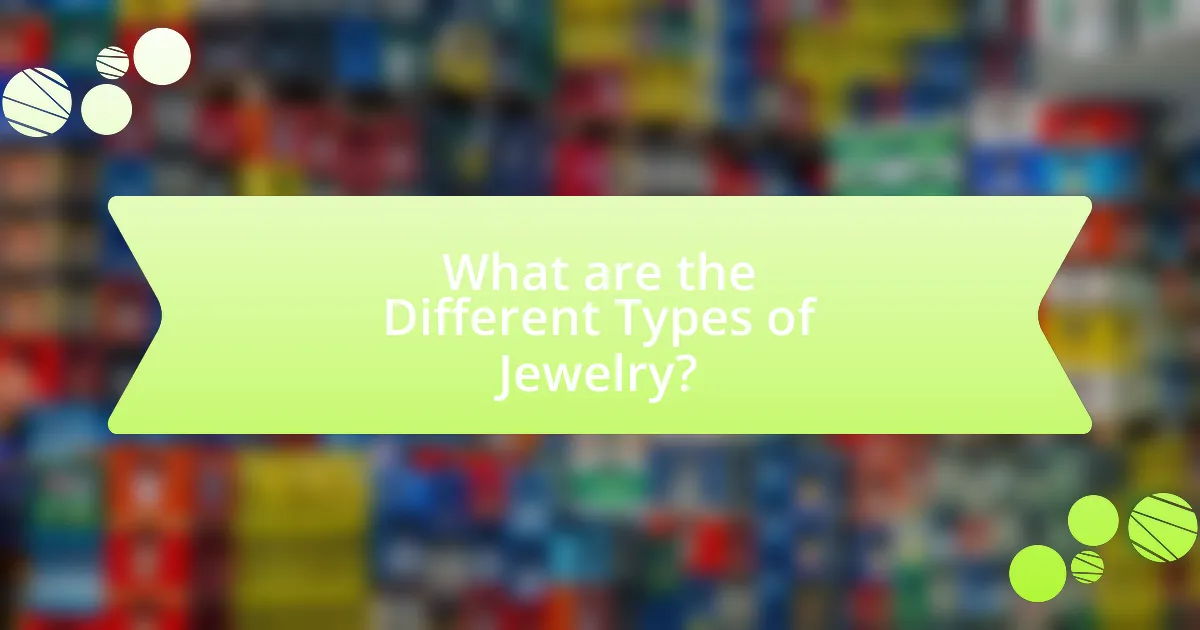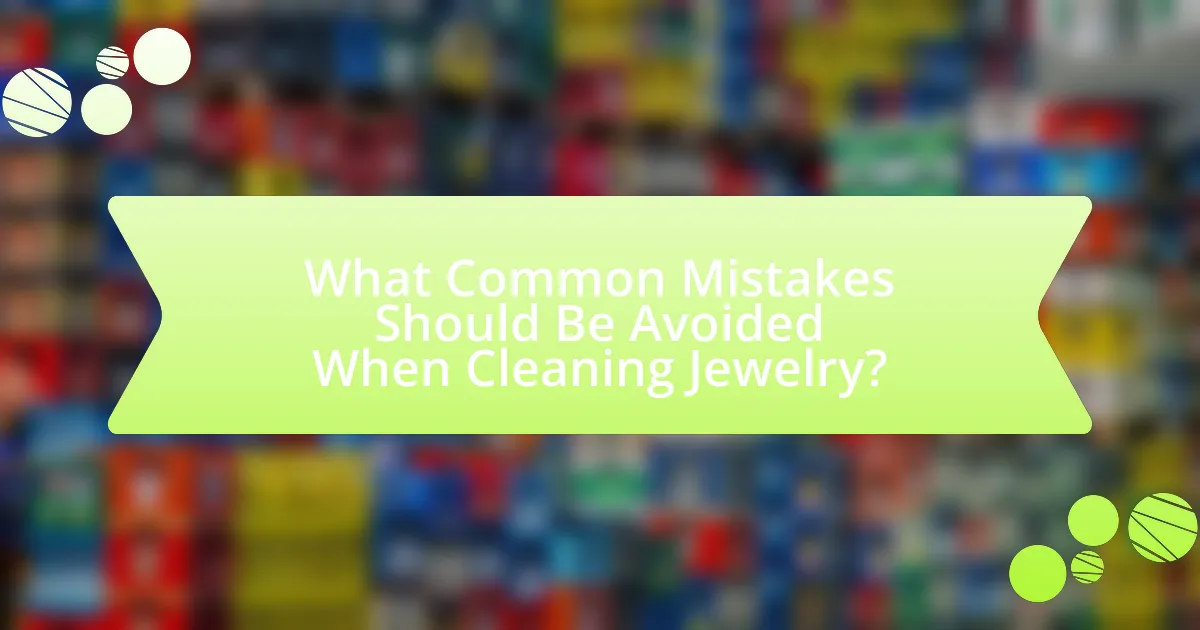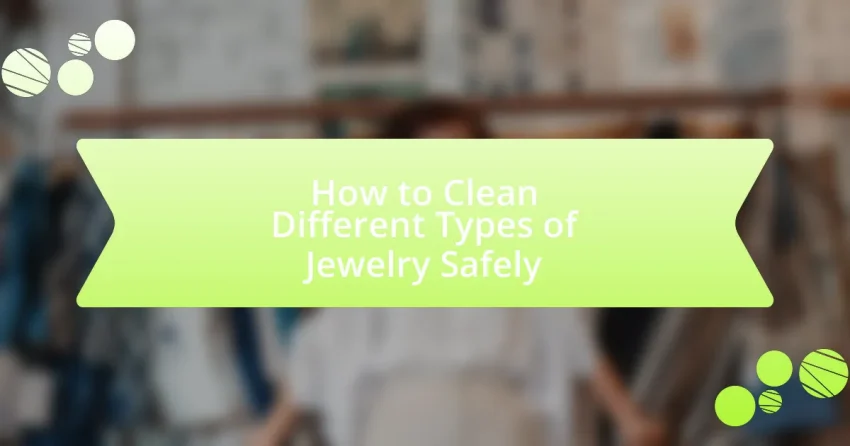The article focuses on the safe cleaning methods for various types of jewelry, including necklaces, bracelets, earrings, rings, brooches, and anklets. It details the impact of different materials, such as gold, silver, and gemstones, on cleaning techniques and emphasizes the importance of regular maintenance to preserve jewelry’s appearance and longevity. Specific cleaning requirements for gold and silver jewelry are outlined, along with best practices for handling gemstone pieces. Additionally, the article addresses common mistakes to avoid during cleaning and offers tips for maintaining jewelry cleanliness and storage solutions to prevent damage.

What are the Different Types of Jewelry?
The different types of jewelry include necklaces, bracelets, earrings, rings, brooches, and anklets. Each type serves a unique purpose and can be made from various materials such as gold, silver, gemstones, and beads. For instance, necklaces can range from simple chains to elaborate statement pieces, while earrings can be studs, hoops, or dangling designs. Rings often symbolize commitment or fashion, and brooches are used for decoration or to fasten clothing. Anklets are typically worn around the ankle and can be casual or ornate. This classification is widely recognized in the jewelry industry and helps consumers understand the variety available for personal adornment.
How do the materials of jewelry affect cleaning methods?
The materials of jewelry significantly influence the appropriate cleaning methods used. Different materials, such as gold, silver, platinum, and gemstones, have varying levels of durability and susceptibility to damage from cleaning agents. For instance, gold and platinum are resistant to tarnishing and can be cleaned with mild soap and water, while silver tarnishes easily and may require specialized silver polish. Gemstones, like pearls and opals, are softer and can be damaged by harsh chemicals, necessitating gentle cleaning with a damp cloth. Therefore, understanding the specific properties of each material is essential for selecting the correct cleaning method to avoid damage and maintain the jewelry’s integrity.
What are the cleaning requirements for gold jewelry?
To clean gold jewelry, use a solution of warm water and mild dish soap, soaking the jewelry for about 15-20 minutes. After soaking, gently scrub the jewelry with a soft-bristle toothbrush to remove dirt and grime, then rinse it thoroughly under warm running water. Finally, dry the jewelry with a soft, lint-free cloth. This method is effective because it avoids harsh chemicals that can damage the gold, ensuring the jewelry maintains its shine and integrity.
How should silver jewelry be cleaned safely?
Silver jewelry should be cleaned safely using a mild soap solution and a soft cloth. To do this, mix a few drops of mild dish soap with warm water, dip the cloth into the solution, and gently wipe the jewelry. Rinse the silver under lukewarm water to remove any soap residue, then dry it thoroughly with a clean, soft cloth. This method is effective because it avoids harsh chemicals that can damage the silver’s surface and maintains its shine without causing scratches.
What special care is needed for gemstone jewelry?
Gemstone jewelry requires careful handling to maintain its beauty and integrity. To protect gemstones, avoid exposing them to harsh chemicals, extreme temperatures, and prolonged sunlight, as these factors can cause damage or fading. Regular cleaning should be done with a soft cloth and mild soap solution, ensuring that abrasive materials are not used, which can scratch the surface. Additionally, storing gemstone jewelry separately in a soft pouch or lined box prevents scratches and tangling with other pieces. These practices help preserve the quality and appearance of gemstone jewelry over time.
Why is it important to clean jewelry regularly?
Cleaning jewelry regularly is important to maintain its appearance and prevent damage. Regular cleaning removes dirt, oils, and tarnish that can accumulate over time, which can dull the shine and luster of the jewelry. Additionally, neglecting to clean jewelry can lead to the buildup of harmful substances that may cause corrosion or degradation of materials, particularly in pieces made from softer metals or gemstones. For instance, according to the Gemological Institute of America, regular maintenance can extend the life of jewelry and preserve its value, ensuring that it remains in optimal condition for years to come.
What are the benefits of maintaining clean jewelry?
Maintaining clean jewelry enhances its appearance and longevity. Regular cleaning removes dirt, oils, and tarnish, which can dull the shine and luster of precious metals and gemstones. For instance, tarnish can lead to corrosion over time, particularly in silver jewelry, reducing its structural integrity. Additionally, clean jewelry is less likely to harbor bacteria and allergens, promoting skin health. Studies have shown that wearing clean jewelry can prevent skin irritations and infections, particularly for individuals with sensitive skin. Therefore, the benefits of maintaining clean jewelry include improved aesthetics, increased durability, and enhanced skin safety.
How does dirt and grime affect jewelry longevity?
Dirt and grime significantly reduce jewelry longevity by causing corrosion, tarnishing, and wear. When jewelry accumulates dirt and grime, it can trap moisture and create an environment conducive to oxidation, particularly in metals like silver and gold. This oxidation leads to tarnishing, which not only affects the appearance but can also weaken the structural integrity of the jewelry over time. Additionally, abrasive particles in dirt can scratch and dull gemstones and metal surfaces, further diminishing their aesthetic and functional qualities. Regular cleaning and maintenance can mitigate these effects, preserving the jewelry’s appearance and durability.

What are the Best Practices for Cleaning Jewelry?
The best practices for cleaning jewelry include using a gentle soap solution, avoiding harsh chemicals, and utilizing soft brushes or cloths for scrubbing. A mixture of warm water and mild dish soap effectively removes dirt and oils without damaging the jewelry. For intricate pieces, a soft-bristled toothbrush can reach crevices without scratching the surface. Additionally, rinsing thoroughly with clean water and drying with a soft cloth prevents water spots and tarnishing. Regular cleaning, approximately every few weeks, helps maintain the jewelry’s appearance and longevity.
How can you safely clean jewelry at home?
To safely clean jewelry at home, use a mixture of warm water and mild dish soap. Soak the jewelry for a few minutes, then gently scrub with a soft toothbrush to remove dirt and grime. Rinse thoroughly under running water and dry with a soft cloth. This method is effective for most types of jewelry, including gold and silver, as it avoids harsh chemicals that can damage the metal or stones.
What household items can be used for cleaning jewelry?
Household items that can be used for cleaning jewelry include baking soda, white vinegar, dish soap, and toothpaste. Baking soda acts as a gentle abrasive that can remove tarnish from metals, while white vinegar can dissolve mineral deposits and grime. Dish soap mixed with warm water creates a safe solution for cleaning delicate pieces, and toothpaste can polish jewelry due to its mild abrasiveness. These items are commonly found in homes and provide effective cleaning solutions without harsh chemicals.
How do you create a safe cleaning solution for jewelry?
To create a safe cleaning solution for jewelry, mix equal parts of mild dish soap and warm water in a bowl. This solution effectively cleans most types of jewelry without causing damage. The use of mild dish soap is crucial, as harsh chemicals can tarnish or degrade materials like gold, silver, and gemstones. Additionally, warm water helps to loosen dirt and grime, making the cleaning process more effective.
What tools are recommended for cleaning jewelry?
Recommended tools for cleaning jewelry include a soft-bristle toothbrush, microfiber cloth, jewelry cleaning solution, and a polishing cloth. The soft-bristle toothbrush effectively removes dirt and grime from intricate designs without scratching the surface. A microfiber cloth is ideal for buffing and polishing, ensuring a shine without leaving lint. Jewelry cleaning solutions, specifically formulated for various materials, help dissolve tarnish and buildup safely. Lastly, a polishing cloth, often treated with cleaning agents, enhances the luster of metals and gemstones. These tools are widely endorsed by jewelers for maintaining the appearance and integrity of jewelry.
How do you use a jewelry cleaning brush effectively?
To use a jewelry cleaning brush effectively, hold the brush at a slight angle and gently scrub the jewelry in small circular motions. This technique allows for thorough cleaning without scratching the surface. For optimal results, use a soft-bristled brush specifically designed for jewelry, as it prevents damage to delicate materials. Additionally, ensure the jewelry is pre-soaked in a suitable cleaning solution to loosen dirt and grime before brushing. This method is validated by jewelers who recommend using a brush to reach intricate details and settings that cloths cannot clean effectively.
What is the role of ultrasonic cleaners in jewelry maintenance?
Ultrasonic cleaners play a crucial role in jewelry maintenance by using high-frequency sound waves to create microscopic bubbles in a cleaning solution, which effectively remove dirt, grime, and tarnish from intricate jewelry designs. This method is particularly effective for cleaning items with hard-to-reach areas, such as settings and crevices, ensuring a thorough clean without damaging the jewelry. Studies have shown that ultrasonic cleaning can remove contaminants more efficiently than traditional cleaning methods, making it a preferred choice among jewelers and consumers alike.

What Common Mistakes Should Be Avoided When Cleaning Jewelry?
Common mistakes to avoid when cleaning jewelry include using harsh chemicals, which can damage the metal and stones, and neglecting to test cleaning solutions on a small area first. Additionally, using abrasive materials can scratch surfaces, while failing to properly rinse and dry jewelry can lead to residue buildup. It is also important to avoid soaking delicate pieces for extended periods, as this can weaken settings and cause stones to loosen. These practices are supported by expert recommendations from jewelers and cleaning specialists, emphasizing the need for gentle, appropriate methods tailored to specific materials.
What are the risks of using harsh chemicals on jewelry?
Using harsh chemicals on jewelry can lead to significant damage, including corrosion, discoloration, and deterioration of materials. For instance, chemicals like bleach or ammonia can erode metals such as silver and gold, causing them to lose their luster and structural integrity. Additionally, harsh chemicals can weaken gemstones, leading to cracks or loss of brilliance. Research indicates that exposure to such substances can result in irreversible damage, emphasizing the importance of using gentle cleaning methods specifically designed for jewelry care.
How can improper cleaning techniques damage jewelry?
Improper cleaning techniques can damage jewelry by causing scratches, weakening structural integrity, and degrading materials. For instance, using abrasive cleaners can scratch the surface of gemstones and metals, leading to a loss of luster and clarity. Additionally, excessive heat or harsh chemicals can weaken settings, potentially causing stones to become loose or fall out. Research indicates that certain cleaning methods, such as ultrasonic cleaners, can be harmful to porous stones like opals and pearls, which can absorb chemicals and moisture, leading to irreversible damage.
What should you avoid when cleaning delicate pieces?
When cleaning delicate pieces, you should avoid using harsh chemicals and abrasive materials. Harsh chemicals can damage the finish and integrity of delicate items, while abrasive materials can scratch or wear down surfaces. For example, ammonia-based cleaners can tarnish metals and degrade certain gemstones. Additionally, avoid using excessive force or scrubbing, as this can lead to breakage or loosening of settings.
How can you troubleshoot cleaning issues with jewelry?
To troubleshoot cleaning issues with jewelry, first identify the type of jewelry and the specific cleaning problem, such as tarnishing, discoloration, or residue. For example, if silver jewelry is tarnished, use a silver polish or a mixture of baking soda and water to gently clean it. If gemstones appear dull, ensure that the cleaning solution is safe for the specific stone type, as some may be sensitive to harsh chemicals. Additionally, check for any loose stones or damage before cleaning, as this may require professional repair. Regular maintenance, such as storing jewelry in anti-tarnish pouches, can prevent future cleaning issues.
What steps should you take if jewelry becomes tarnished after cleaning?
If jewelry becomes tarnished after cleaning, the first step is to gently clean the tarnished area with a soft cloth or a specialized jewelry cleaning cloth. This method helps remove surface tarnish without scratching the metal. If tarnish persists, a mild solution of warm water and dish soap can be used to soak the jewelry for a few minutes, followed by a gentle scrub with a soft brush. Rinse thoroughly with clean water and dry completely with a soft cloth.
Tarnishing occurs due to exposure to moisture, air, and certain chemicals, and using appropriate cleaning methods can restore the jewelry’s shine. Regular maintenance and proper storage can prevent future tarnishing.
How do you handle stubborn stains on jewelry safely?
To handle stubborn stains on jewelry safely, use a gentle cleaning solution such as a mixture of warm water and mild dish soap. Soak the jewelry for a few minutes, then use a soft-bristle toothbrush to gently scrub the stained areas. Rinse the jewelry thoroughly under running water to remove any soap residue, and dry it with a soft cloth. This method is effective because it avoids harsh chemicals that can damage the jewelry while still providing enough cleaning power to remove stains.
What are the best tips for maintaining jewelry cleanliness?
To maintain jewelry cleanliness, regularly clean pieces with a soft cloth to remove dirt and oils. This simple practice prevents buildup and keeps jewelry looking its best. Additionally, using a mild soap solution and a soft brush can effectively clean more intricate designs without damaging them. For specific materials, such as gold or silver, using a specialized cleaner can enhance shine and remove tarnish. Storing jewelry in a dry, separate space, away from direct sunlight and moisture, further protects it from damage and maintains its cleanliness. Regular maintenance, including professional cleaning for valuable pieces, ensures longevity and preserves the jewelry’s appearance.
How often should you clean different types of jewelry?
Different types of jewelry should be cleaned at varying frequencies based on their materials and usage. Fine jewelry, such as gold and platinum, should be cleaned every 1 to 3 months to maintain its shine and remove dirt. Silver jewelry requires cleaning every 2 to 4 weeks to prevent tarnishing. Costume jewelry should be cleaned every 1 to 2 months, while pieces worn daily, like engagement rings, should be cleaned weekly to remove oils and dirt. Regular cleaning helps preserve the integrity and appearance of the jewelry, as dirt and oils can cause damage over time.
What storage solutions help keep jewelry clean and safe?
Jewelry boxes with individual compartments help keep jewelry clean and safe by preventing scratches and tangling. These boxes often feature soft linings, which protect delicate pieces from damage. Additionally, anti-tarnish pouches or cloths can be used to store silver jewelry, as they absorb moisture and prevent tarnishing. Furthermore, using airtight containers or zip-lock bags can protect jewelry from dust and humidity, which are common causes of deterioration. Studies indicate that proper storage significantly extends the lifespan of jewelry, making these solutions effective for maintaining both cleanliness and safety.
